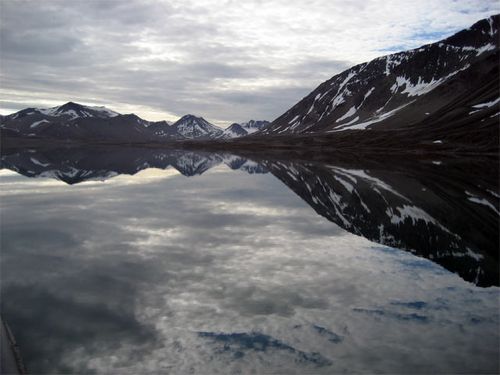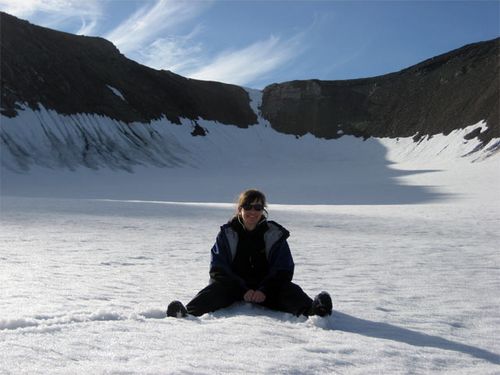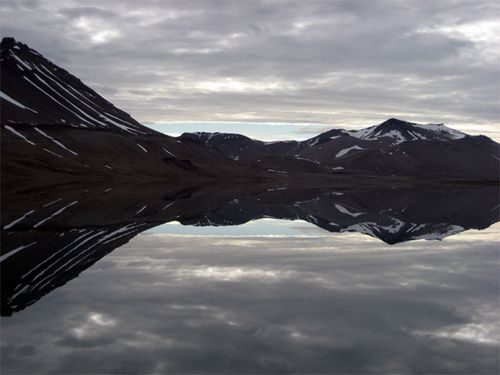
When I arrived here in Svalbard over a month ago, the amount of time ahead of me at Isfjord Radio and the Linne Valley appeared to be inordinate, but looking back at all that was accomplished and all that could still be accomplished, the time here was actually too short. We had the time to visit places in the Linne Valley that most people will never experience, and had the unique opportunity to investigate the inner workings of the glacier, river, and lake system in order to truly understand how this system operates. And yet the more we delved into the system, the more we wanted to investigate. The wonder of science left us with more questions than we could answer in our brief visit to the outdoor laboratory of the Linne Valley; questions we'll leave for the next cohort of Svalbard REU students to investigate.
In one of my first journal entries upon arriving in Svalbard I mentioned how surreal the surroundings were, but this place quickly became my reality. Thoughts of trees, sunrises, sunsets, nighttime, warm summer air, quickly disappeared as the revealing naked landscape of the tundra, the beauty of snow and ice filled cavities of the mountains, and the crisp blue skies at midnight entered into my daily repertoire. In the beginning the distances were so deceiving, and what appeared to be a few minutes away were in actuality hours away. Over time these distances shrunk and I began to recognize certain rock out crops, sorted circles, streams, etc, all which helped me define these distances. The "north end boat dock," the "red hut," the "boot station," the "discharge station," "ablation stake #1," and the "Little Ice Age moraine," were a few of my distance markers. My feet learned where to step to avoid getting stuck in the mud and I learned a couple of lessons the hard way: 1. never hike behind someone with longer legs than me, and 2. never hike behind someone wearing muck boots when I'm not!

Adjusting to the persistent daylight of the Arctic was facilitated by our field and meal schedule although there was always a sense of "awake-ness" even as I slept. It was easier to get up in the morning and easier to work long hours in the field with the assistance of the long lived sunlight. For me the impending darkness of the New Jersey nights will be as surreal as Svalbard once was, although the moon and stars I missed seeing while here will be a welcome sight when I return. Adjusting to the persnickety daily weather of Svalbard became a game of outwitting the daily conditions with a variety of clothing. The climatic conditions suggested dressing for a typical New Jersey winter, although the variety of weather conditions felt on a daily basis meant being prepared for anything. To win the game, I relied on the advice of our PI's and the safety training we received when we first arrived in Longyearbyen. Our safety coach mentioned that being prepared for the wind is more important than being prepared for the precipitation. I found that to be sound advice and chose to wear a windproof jacket and pants along with an assortment of layers below on a daily basis. With the right clothing and continual physical activity, the weather was a non-issue, and all my fears of not adjusting to the cold quickly melted away. Hiking back to the station each day I kept thinking of how fortunate I was to be outside doing what I love in such a pristine environment, and I'm not looking forward to going home to the claustrophobic conditions of the New Jersey metropolitan area, although I'm fortunate to have a few wonderful hiking trails not too far away.
There's always a question about potential group dynamics when a group of people come together for the first time, but in the case of the Svalbard REU team we were cohesive right from the start. Al, Mike, Steve have natural abilities to lead, coach, nurture, and inspire the students to do their best, push harder when necessary, and exercise their minds when analyzing their surroundings. It was a treat watching Al and Mike in their one-on-one interactions with the students, and how they gently prodded them, but always made them feel the ownership of their projects. As an educator, I have a responsibility to my profession to reflect upon my skills and abilities, and to seek out ways to grow and develop into a better teacher. One of my favorite forms of professional development is to spend time with other educators where the rich dialogue that ensues contains numerous ideas I can apply to my own teaching situations. I'm thankful for the opportunity to have worked with Al and Mike, both of whom are master educators and role models for others.
The Svalbard REU students are all bright, witty, and have promising futures. It was fun for me to be a "fly on the wall" watching and listening to their interactions with the others and with Mike and Al. From this I learned about their unique personalities and about their sometimes naïve yet refreshing and optimistic outlook on life. As young scientists, they successfully challenged their mental and physical abilities while accomplishing the goals of their field research, and I hope to keep in touch with all of them as they move into their chosen career paths. My job will be to convey to my students and colleagues what a wonderful experience this was for the students and how valuable a field research experience is in the career of undergraduate science majors.
Although I sometimes felt like a roving reporter, my mind was always working on ways to bring this PolarTREC expedition back to my classroom. Textbooks can be as dry as toast, even when the content is about exciting topics such as glaciation or the climate, but with the addition of the resources I've garnered from the expedition, I can bring these topics alive. I've learned a tremendous amount about atmosphere/cryosphere/geosphere interactions and I look forward to developing numerous lab experiences for my students using the data from the expedition or from the use of online resources related to International Polar YearThe International Polar Year (IPY) is a two year (2007-2009) program of international research and education focused on the Arctic and Antarctic. Click here for more information about IPY. and the Arctic. My school community has the remnants of an old glacial lake residing within walking distance from the school, and my desire is to utilize the glacial history of this region to engage my students in learning about their community. This expedition will never be far from my mind and even though my curriculum is not based on the Arctic, my experience will shine through in most of the topics I teach. Whether it's about lab or field methods, data use, physical processes, what I've learned will be invaluable to what I teach for years to come.
I want to thank all of those involved in my expedition for providing me with a life-changing experience that will live in my mind and heart forever. Thank you for all your assistance and patience before and during the expedition. Big thanks to everyone for following the Svalbard REU Team on our High Arctic Change 08 expedition! Check back on occasion as additional items may be posted!
Task of the day: If you participated in the polar bear and CHS cougar contest, be sure to send me your numbers by September 5th along with your full name, age, and address. All correct entries will receive a prize, and one of the correct entries will receive a "grand" prize! This information must be sent to me at mholzer [at] polartrec.com

- < prev
- 42 of 42


Comments